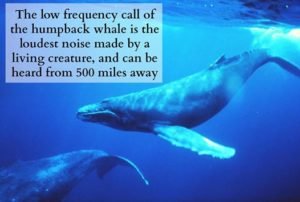
Whales and dolphins are mammals and cannot breathe water but must come up for air. There are about 80 species. Whales are the largest and most intelligent animals in the sea. They live everywhere. Dolphins are a kind of small whale and even live in some rivers There are two types of whales:
1. Baleen whales – like the rorqual, gray, right, pygmy (bristles)
2. Toothed whales like the sperm, beaked, narwhal, beluga, dolphin, porpoise and they have from a few teeth to many.
Whales have sleek streamlined blubbery bodies, oily skin, two flippers, a HORIZONTAL tail and tail flukes. Fish have vertical tails. BREACHING is when they jump out of the water. SPYHOPPING is looking out of the water. Sometimes whales will hold their tail up and sail in the wind for fun.
Baby whales are born under the water tail first and are called calves. The mother gives birth near the waters surface and she lifts them out of the water so they can breathe. The baby feeds from teats in slits on the mother’s belly. The milk has lots of fat. Baby whales stay with the mother for 2-3 years. Pods are fixed family groups. There are schools, pods and nursery groups. Pairs of male bottlenose dolphins are known to stay together for 15 years. Toothed whales may live in groups of as many as 500.
Sperm whales have the largest head of any animal and have dark wrinkled skin
Belugas are smooth and white. They have callosites and lice on their skin. Blue whales are the largest whales – longer than 3 busses and weigh as much as 25 elephants. The humpback whale has the longest flippers – 16 ½ inches long. Baleen whales have 2 blowholes side by side. Toothed whales have 1 blowhole. The single breath from a blue whale can blow up 2000 balloons.
Some whales can go as fast as 35 mph. They chase each other in a dance. Southern right whales are slow swimmers and float to the surface if killed.
The porpoises are the smallest whales. There are tales of dolphins saving people from sharks
Whales have 4 senses = sight, touch, taste, and hearing. They hear by detecting vibration through a small opening behind the eye. Their eyes have a constant trickle of oily tears to wash away dirt; they see well. They can even see in dim light. Their eye reflects the light back. Whales have touch sensitive skin. They use sound to hunt food, find their way and communicate with each other through echolocation. Sperm whales have an oily wax in their heads they use for weight and echolocation. The humpback whales make groans, moans, trills, chirps and a love song. The longest heard lasted for 22 hours.
Whales travel long distances for food (warm water), to mate, or to give birth (cold water). The gray whales migrate the longest and are the most curious. Whales find their way with the help of the magnetic forces of the earth. Toothed whales usually don’t migrate, but belugas do.
Whales used to be hunted for their blubber, meat, and oil but they are endangered and hunting them is banned now.
The Rorqual whales are the longest, the loudest, and the heaviest. Blue whales have folds of skin. Their throat grooves unfold to eat. Their tail flukes are 26 feet wide, and their heart is the size of a small car. Humpbacks have shorted fatter bodies and longer flippers. They use bubble netting to catch fish. They circle beneath a school of fish blowing bubbles, then swim through the bubble net trap and gulp down a mouth full of fish. The gray whales roll over on sides and suck up water and mud for food. The bowhead whale (a right whale) lives the longest, 130 years.
